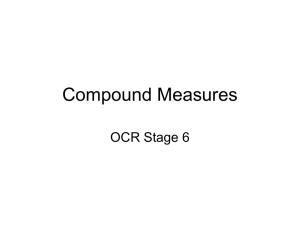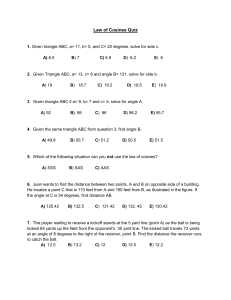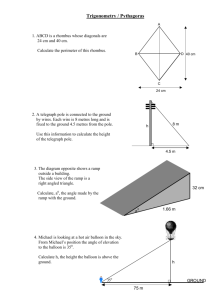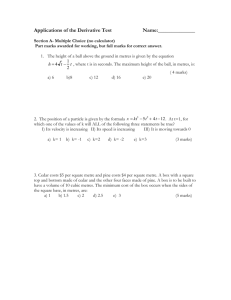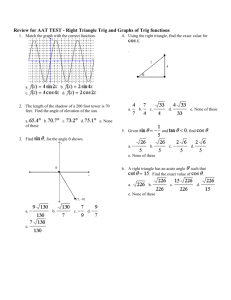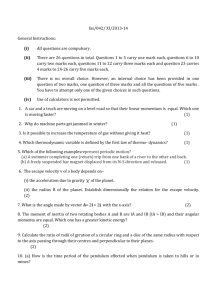Questions - IB Math Studies (Class of 2014)
advertisement
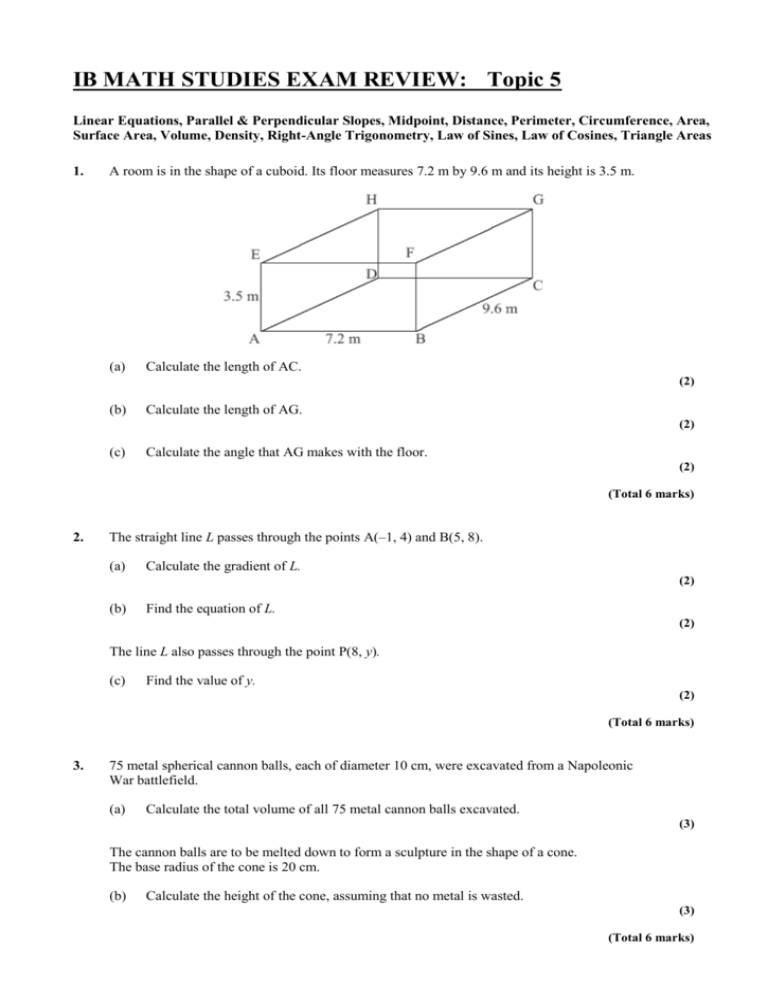
IB MATH STUDIES EXAM REVIEW: Topic 5 Linear Equations, Parallel & Perpendicular Slopes, Midpoint, Distance, Perimeter, Circumference, Area, Surface Area, Volume, Density, Right-Angle Trigonometry, Law of Sines, Law of Cosines, Triangle Areas 1. A room is in the shape of a cuboid. Its floor measures 7.2 m by 9.6 m and its height is 3.5 m. (a) Calculate the length of AC. (2) (b) Calculate the length of AG. (2) (c) Calculate the angle that AG makes with the floor. (2) (Total 6 marks) 2. The straight line L passes through the points A(–1, 4) and B(5, 8). (a) Calculate the gradient of L. (2) (b) Find the equation of L. (2) The line L also passes through the point P(8, y). (c) Find the value of y. (2) (Total 6 marks) 3. 75 metal spherical cannon balls, each of diameter 10 cm, were excavated from a Napoleonic War battlefield. (a) Calculate the total volume of all 75 metal cannon balls excavated. (3) The cannon balls are to be melted down to form a sculpture in the shape of a cone. The base radius of the cone is 20 cm. (b) Calculate the height of the cone, assuming that no metal is wasted. (3) (Total 6 marks) 4. In the diagram, AD = 4 m, AB = 9 m, BC = 10 m, BD̂A = 90° and DB̂C = 100°. (a) Calculate the size of AB̂C . (3) (b) Calculate the length of AC. (3) (Total 6 marks) 5. José stands 1.38 kilometres from a vertical cliff. (a) Express this distance in metres. (1) José estimates the angle between the horizontal and the top of the cliff as 28.3° and uses it to find the height of the cliff. (b) Find the height of the cliff according to José’s calculation. Express your answer in metres, to the nearest whole metre. (3) (c) The actual height of the cliff is 718 metres. Calculate the percentage error made by José when calculating the height of the cliff. (2) (Total 6 marks) 6. 1 The straight line, L1, has equation y = x – 2. 2 (a) Write down the y intercept of L1. (1) (b) Write down the gradient of L1. (1) The line L2 is perpendicular to L1 and passes through the point (3, 7). (c) Write down the gradient of the line L2. (1) (d) Find the equation of L2. Give your answer in the form ax + by + d = 0 where a, b, d . (3) (Total 6 marks) 7. The diagram shows a triangle ABC in which AC = 17 cm. M is the midpoint of AC. Triangle ABM is equilateral. (a) Write down (i) the length of BM in cm; (ii) the size of angle BMC; (iii) the size of angle MCB. (3) (b) Calculate the length of BC in cm. (3) (Total 6 marks) 8. The diagram represents a small, triangular field, ABC, with BC = 25 m, angle BAC = 55° and angle ACB = 75°. (a) Write down the size of angle ABC. (1) (b) Calculate the length of AC. (3) (c) Calculate the area of the field ABC. (3) N is the point on AB such that CN is perpendicular to AB. M is the midpoint of CN. (d) Calculate the length of NM. (3) A goat is attached to one end of a rope of length 7 m. The other end of the rope is attached to the point M. (e) Decide whether the goat can reach point P, the midpoint of CB. Justify your answer. (5) (Total 15 marks) 9. The diagram shows an office tower of total height 126 metres. It consists of a square-based pyramid VABCD on top of a cuboid ABCDPQRS. V is directly above the centre of the base of the office tower. The length of the sloping edge VC is 22.5 metres and the angle that VC makes with the base ABCD (angle VCA) is 53.1°. diagram not to scale (a) (i) Write down the length of VA in metres. (ii) Sketch the triangle VCA showing clearly the length of VC and the size of angle VCA. (2) (b) Show that the height of the pyramid is 18.0 metres correct to 3 significant figures. (2) (c) Calculate the length of AC in metres. (3) (d) Show that the length of BC is 19.1 metres correct to 3 significant figures. (2) (e) Calculate the volume of the tower. (4) To calculate the cost of air conditioning, engineers must estimate the weight of air in the tower. They estimate that 90 % of the volume of the tower is occupied by air and they know that 1 m3 of air weighs 1.2 kg. (f) Calculate the weight of air in the tower. (3) (Total 16 marks) 10. The diagram shows triangle ABC. Point C has coordinates (4, 7) and the equation of the line AB is x + 2y = 8. (a) Find the coordinates of (i) A; (ii) B. (2) (b) Show that the distance between A and B is 8.94 correct to 3 significant figures. (2) N lies on the line AB. The line CN is perpendicular to the line AB. (c) Find (i) the gradient of CN ; (ii) the equation of CN. (5) (d) Calculate the coordinates of N. (3) It is known that AC = 5 and BC = 8.06. (e) Calculate the size of angle ACB. (3) (f) Calculate the area of triangle ACB. (3) (Total 18 marks) 11. (a) A gardener has to pave a rectangular area 15.4 metres long and 5.5 metres wide using rectangular bricks. The bricks are 22 cm long and 11 cm wide. (i) Calculate the total area to be paved. Give your answer in cm2. (ii) Write down the area of each brick. (iii) Find how many bricks are required to pave the total area. (6) (b) The gardener decides to have a triangular lawn ABC, instead of paving, in the middle of the rectangular area, as shown in the diagram below. The distance AB is 4 metres, AC is 6 metres and angle BAC is 40°. (i) Find the length of BC. (ii) Hence write down the perimeter of the triangular lawn. (iii) Calculate the area of the lawn. (iv) Find the percentage of the rectangular area which is to be lawn. (9) (c) In another garden, twelve of the same rectangular bricks are to be used to make an edge around a small garden bed as shown in the diagrams below. FH is the length of a brick and C is the centre of the garden bed. M and N are the midpoints of the long edges of the bricks on opposite sides of the garden bed. (i) Find the angle FCH. (ii) Calculate the distance MN from one side of the garden bed to the other, passing through C. (5) The garden bed has an area of 5419 cm2. It is covered with soil to a depth of 2.5 cm. (d) Find the volume of soil used. (2) It is estimated that 1 kilogram of soil occupies 514 cm3. (e) Find the number of kilograms of soil required for this garden bed. (2) (Total 24 marks)
